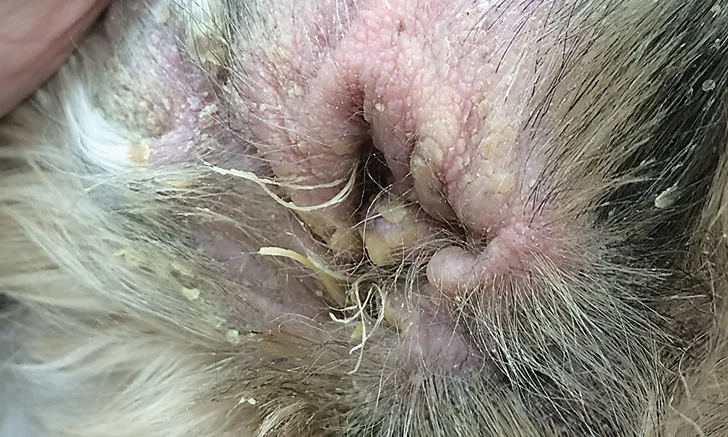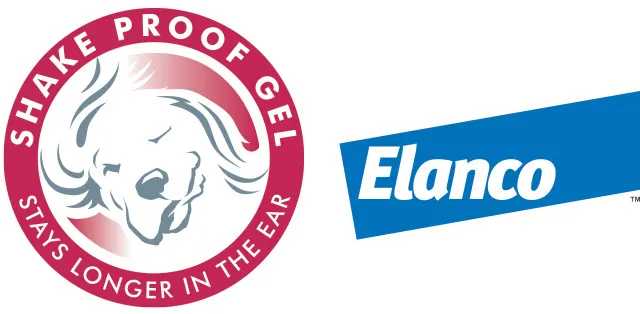Clinical Notes: Otitis Treatment: Some Welcome Relief

Brought to you by Elanco
Otitis externa is a major reason for insurance claims for dogs.1 It is also fraught with management difficulties, not the least of which are the pain and hassle of medicating the dog. For years, veterinarians have had to rely on once- to twice-daily otic products, making compliance a challenge. More recently ear packs containing an antibiotic, antifungal, and topical corticosteroid have become available; however, there have been anecdotal concerns regarding these lanolin-based products causing deafness.

Osurnia®, an innovative adaptable gel product from Elanco, offers veterinarians an easily administered alternative to traditional otitis treatments without the need for an owner to remember, and be able, to insert daily or twice-daily drops into the dog’s inflamed ears. Containing the antibiotic florfenicol, the antifungal terbinafine, and the steroid betamethasone acetate, Osurnia is indicated for the treatment of canine otitis externa associated with susceptible strains of bacteria (Staphylococcus pseudintermedius) and yeast (Malassezia pachydermatis).2
Key Points
Otitis is a multi-component disorder that requires investigation of primary, predisposing, and perpetuating factors.
Pain and discomfort make compliance with veterinary recommendations problematic for even diligent pet owners.
The 2-time-only application method for Osurnia® provides up to 45 days of efficacy to bring relief for pet and owner and a route to successful treatment.
Osurnia requires only 2 doses, applied one week apart. Each dose comes premeasured in an easy-to-use applicator with a flexible tip. The first dose is applied in the clinic, alleviating owners of the stress of medicating the painful and inflamed ears of their dog. After the ear has been cleaned, Osurnia is deposited into the ear, and gentle massage allows the gel formulation to coat and adhere to the ear canal surface. A second dose is then administered 7 days later at a medical progress examination. The need for only 2 doses of Osurnia, and in-clinic administration, make the treatment of the condition convenient for pet owners. The ingredients in the gel provide up to 45 days of efficacy and owners do not need to, in fact should NOT clean their dog’s ears during this time. This regimen allows the dog to recover without the repeated application of medications, cleaners, wipes, and cotton.
Important Safety Information
OSURNIA (florfenicol/terbinafine/betamethasone acetate) is for otic use only under veterinary supervision. Do not use in dogs with known tympanic perforation or a hypersensitivity to florfenicol, terbinafine or corticosteroids. Adverse reactions observed during clinical trials include vomiting, increased liver enzymes and transient loss of hearing. See OSURNIA product label for full prescribing information or call 1-888-545-5973.
Approaching an Otitis Case
Taking a thorough history is an important first step in determining the cause of otitis. Important information can be gleaned including seasonality, recurrence, possible triggers, concurrent or previous dermatologic signs, other pets affected, etc. It is important when working up an otitis case to have 2 goals: 1) to identify and treat the primary cause, and 2) to identify and manage concurrent perpetuating causes. (see Table) Treating only the infection, for example, without addressing the primary factor will most likely result in treatment failure or recurrence.
Common Predisposing, Primary, and Perpetuating Factors in Otitis
*Create risk
†Impede resolution
††Do not use Osurnia in dogs with known tympanic perforation.
Once a thorough history has been obtained, both the external ear canals and pinnae should be thoroughly examined for the presence of erythema, exudate, discharge, odor, crusting, scaling, and swelling/stenosis. Evaluation of the cartilage to determine if it is soft and pliable or firm, the latter suggesting fibrosis or calcification, should be conducted. Both ears should be examined, including otoscopically, even if only unilateral disease is present. A full dermatologic examination of the patient should also be performed to assess for concurrent dermatologic disease/clinical signs.
An Important Key to Treating Otitis
Cytologic evaluation of the otic exudate, collected using a cotton-tipped applicator,3 is a simple and inexpensive test that can help the veterinarian to successfully treat an individual case. Both ears can be evaluated on the same slide by separating the samples to opposite ends. The slide is heat fixed and treated with Romanowsky stain (eg, Diff-Quik) and then examined under the microscope for numbers and types of bacteria, yeast, and inflammatory cells. This information generates immediate guidance in the design of a treatment plan as well as immediate feedback to owners as to what type of infection may be present. In addition, taking cytology at medical progress examinations helps the clinician assess response to treatment. The failure to do an initial cytologic examination may result in use of an ineffective treatment, resulting in perpetuation of the problem.4 In some refractory cases, especially those involving rod-shaped organisms, culture and susceptibility testing may be needed.
Once cytology indicates whether and what type of infection is present, a treatment plan should be instituted. Ear cleaning is an important component of managing otitis externa, as it can help facilitate examination of the ear canal; remove microbes, small foreign bodies, and debris; and increase exposure of the lining of the ear canal to topical agents. Often the first cleaning can be done in the clinic and then a cleanser can be sent home for use in subsequent ear maintenance once the infection is cleared. In cases of severe otitis, including otitis media, it may be necessary to do a deep ear cleaning and evaluation under anesthesia.
In the presence of either Staphylococcus pseudintermedius or Malassezia pachydermatis, using Osurnia® allows the practitioner the freedom to treat the ear while investigating for the underlying triggers. Meanwhile, the simplified, 2-time-only application eliminates the issue of owner compliance.
Osurnia is also a good choice in patients that are being treated for atopy or food allergy but occasionally flare with otitis externa during allergy season. The residual activity of its active ingredients remains up to 45 days, which helps prevent recurrence. The clinician may meanwhile adjust the allergy therapy to avoid those occasional flares.
If cytology is the first key, determining why the dog has otitis is the next. As mentioned earlier, the 2 goals in treating otitis are, first, to identify and treat the primary cause, and then to identify and manage concurrent perpetuating causes. If only the infectious cause is determined and treated, the clinician is setting the scenario for failure and more frequent recurrence. Utilizing the findings from the history, physical/otic/dermatologic examinations, and cytology can help uncover the possible underlying causes. Since allergy is so often a trigger, it is often prudent to begin the dog on a food trial and/or perform a workup for atopic dermatitis while treatment has begun.

Osurnia, Elanco, and the diagonal bar logo are trademarks of Eli Lilly and Company or its affiliates.
© 2017 Eli Lilly and Company or its affiliates.
USCACOSU00088